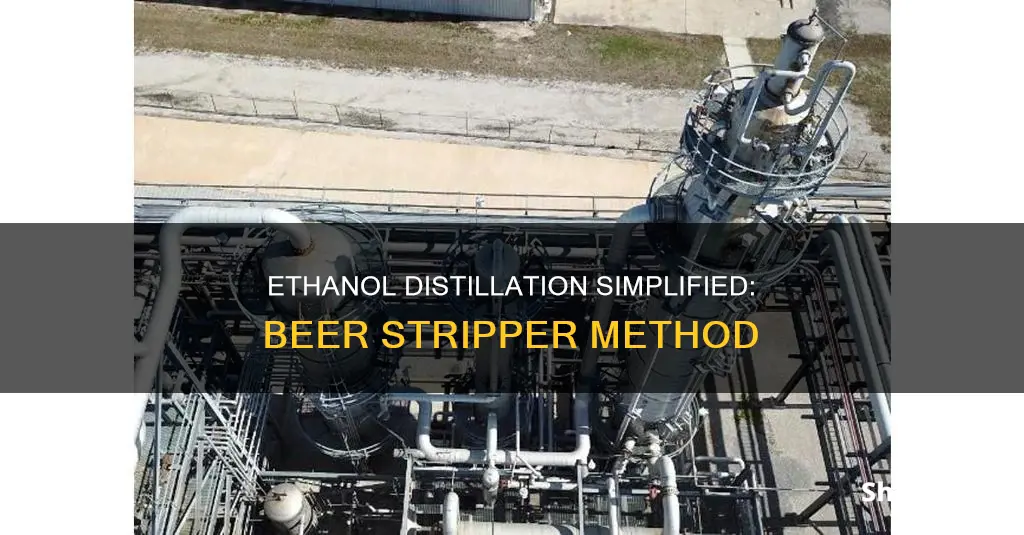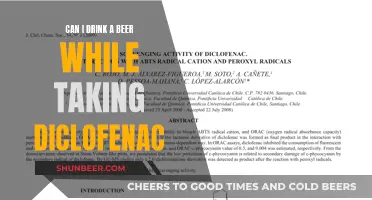
Ethanol distillation is the process of separating alcohol from water in grain fermentation. This process can be done in two ways: batch, or pot, stripping and continuous, or column, stripping. In pot distilling, the fermented liquid is heated, and the ethanol evaporates before the water, travelling into a cooling tube and condensing into a vessel. This process can be repeated to increase the alcohol content. In column distilling, the fermented liquid is continuously injected into a column, with steam rising up to meet it. The steam is heated to a specific temperature to separate the alcohol from the liquid, and the alcohol vapours are continuously refined through the column.
| Characteristics | Values |
|---|---|
| Type of distillation | Continuous, or column, stripping |
| Pot still (batch) stripping | |
| Beer column | Receives beer and produces an intermediate ethanol vapour |
| Rectifier column | Receives the intermediate ethanol vapour from the beer column and produces 190 proof or 95% pure ethanol vapour |
| Side stripper column | Receives bottoms from the rectifier column and then produces an intermediate ethanol overhead vapour that is further purified by the rectifier column |
| Beer bottoms | Include unfermented grain solids and thin stillage comprised mostly of liquid water |
What You'll Learn
- The beer column separates ethanol from water and solids in the beer stream
- The rectifier column refines ethanol vapour into 95% ethanol
- The side stripper column separates ethanol from water so the water can be recycled
- The beer preheater uses the exiting vapour to preheat the incoming beer
- The rectifying condenser condenses vapour leaving the beer preheater

The beer column separates ethanol from water and solids in the beer stream
The beer column is the first of three distillation columns in the ethanol distillation process. It receives a continuous flow of preheated beer, which is 16% ethanol by volume. The beer column separates the ethanol from the water and solids in the beer stream. The ethanol is vaporized and pushed out of the top of the column, along with some of the water. The remaining water and solids exit the bottom of the beer column and are eventually turned into dried distillers grains with solubles (DDGS). The 50% ethanol, 50% water vapour that leaves the top of the beer column is sent to the rectifier column for further purification.
The Science of Beer: Foam Detectors Explained
You may want to see also

The rectifier column refines ethanol vapour into 95% ethanol
The rectifier column is one of three distillation columns used in the ethanol distillation process. The other two are the beer column and the side stripper column.
Understanding Beer Distribution: From Brewery to Glass
You may want to see also

The side stripper column separates ethanol from water so the water can be recycled
The side stripper column is the third of three distillation columns used in the ethanol distillation process. The first column, the beer column, separates the ethanol from the water and solids in the beer stream. The second column, the rectifier column, further refines the ethanol vapour into 95% ethanol, which is then condensed and stored.
The side stripper column receives the remaining stream from the rectifier column, which is approximately 40% ethanol. The purpose of the side stripper column is then to separate the ethanol from the water. The water exits from the bottom of the column and the ethanol is concentrated to approximately 50% and sent back to the rectifier column from the top of the side stripper column. The water that is separated can be recycled back to the front of the plant.
The distillation process separates the 16% ethanol beer into three streams: 190-proof ethanol, water to be recycled, and a water/solids stream that will eventually be turned into DDGS (distillers dried grains with solubles).
Beer Breakdown: Understanding Its Effect on the Human Body
You may want to see also

The beer preheater uses the exiting vapour to preheat the incoming beer
The beer preheater is an integral component of the ethanol distillation process, specifically in the heat exchangers section. This preheater utilises the exiting vapour, which is the vapour leaving the beer column, to preheat the incoming beer, which is the unfermented beer entering the beer column. This design decision is intentional and strategic, offering multiple benefits to the overall distillation process.
Firstly, by using the exiting vapour to preheat the incoming beer, the beer preheater helps to conserve energy. This energy conservation is a crucial aspect of the distillation process, as energy is required to boil the ethanol and turn it into vapour for purification. By preheating the incoming beer, the beer preheater reduces the amount of external energy needed to heat the beer to the desired temperature.
Secondly, the beer preheater plays a role in reducing scaling in the column. Scaling, which is more common with molasses wash than with grain beer, can build up over time and cause operational issues. By preheating the incoming beer, the beer preheater helps to mitigate the formation of scaling, thus contributing to the overall efficiency and longevity of the distillation equipment.
The sizing of the beer preheater is a critical factor. The number of tubes in the preheater, which constitute the heating surface, is determined by the relationship between the beer feed rate and the desired temperature of the beer as it leaves the preheater. A properly sized beer preheater ensures that the beer reaches the optimal temperature for the distillation process, enhancing the overall efficiency of ethanol production.
In summary, the beer preheater is a vital component of the ethanol distillation process, utilising exiting vapour to preheat incoming beer. This design strategy helps to conserve energy, reduce scaling, and ensure optimal beer temperatures, ultimately contributing to the efficiency and effectiveness of ethanol production.
Beer as a Hair Conditioner: Does it Work?
You may want to see also

The rectifying condenser condenses vapour leaving the beer preheater
The rectifying column is used to further purify the ethanol vapour produced by the beer column. The rectifying column produces 190-proof ethanol vapour, which is then condensed into a liquid by the condenser. The rectifying column also produces ethanol vapour with a lower concentration of ethanol, which is sent to the side stripper column for further purification.
The rectifying column is heated by the hot 120-proof vapours that enter it. The vapours are condensed into a liquid by the condenser, which operates at a pressure below atmospheric pressure. The condenser is also used to condense the vapours produced by the side stripper column.
The rectifying column is connected to the beer column, the side stripper column, the condenser, and the carbon dioxide scrubber. The rectifying column receives 120-proof ethanol vapour from the beer column, and 120-proof ethanol vapour from the side stripper column. The rectifying column sends 190-proof ethanol vapour to the condenser, and 40-proof ethanol vapour to the side stripper column.
How Well Do Beer Thermoses Work?
You may want to see also
Frequently asked questions
A beer stripper is a type of distillation column used to separate ethanol from water in the "beer" resulting from the fermentation of grain.
Ethanol has a lower boiling point than water (78.2°C vs 100°C), so it can be separated by heating the beer and collecting the alcohol vapours.
A beer column is a type of beer stripper that receives beer and produces an intermediate ethanol vapour.
A rectifier column receives the intermediate ethanol vapour from the beer column and further distils it into a higher-purity ethanol vapour.
A side stripper column receives the bottoms from the rectifier column and returns an ethanol overhead vapour to the rectifier column for further purification.







